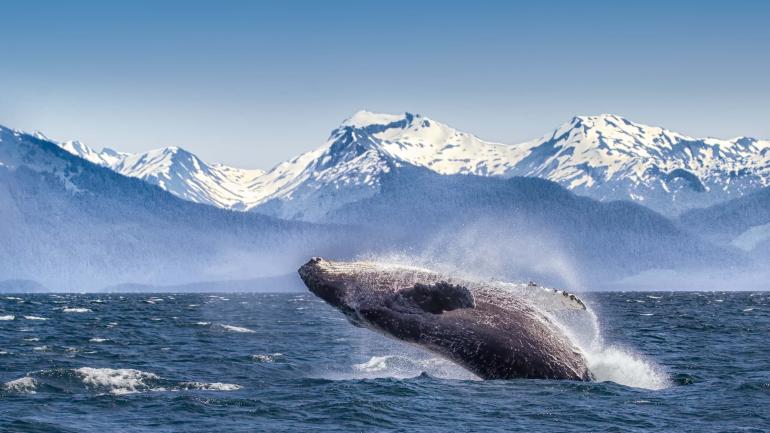It has more national parks than all of the Eastern Seaboard states put together.
You may have heard of Glacier Bay and Denali. But the others aren’t well known or appreciated, so there aren’t many people there.
The park of Denali
Famous for: Denali is another name for Mt. McKinley, which is the biggest mountain in North America. People in the park usually just call it “the mountain,” as in “Can you see the mountain today?” (Hint: It’s likely not possible.)
Good to know: cars can’t go into Denali. The park’s only road is constantly being used by park shuttles and tour buses. Even if you only have one day to ride out and back, you can still see a lot of wildlife and beautiful scenery. But it’s much better to get off the road and walk into the woods.
Denali doesn’t have any official hiking trails, except for a few short ones near the park gate. Instead, visitors are welcome to (respectfully) wander around and camp wherever they want. Before you go into the wild, make sure you have your bear barrel and a good terrain plan.
The park of Denali
The national park of Wrangell-St. Elias
Famous for: Being very big. With 13 million acres, Wrangell-St. Elias is the state park with the most land in the United States. Glacier Bay National Park in Southeast Alaska, Tatshenshini-Alsek Provincial Park in British Columbia, and Kluane National Park in Yukon are all close by. Together, they make up a UNESCO World Heritage Site.
One interesting fact about Wrangell-St. Elias is that you can drive right into the park. From Chitina, which is just outside the park, there is a rough road that goes to the small tourist town of McCarthy and the nearby ghost town of Kennicott.
From Kennicott, a qualified operator leads hikes and climbs on glaciers, and there are also great tours of the historic Kennicott copper mill, which is a 13-story wreck built into the side of the mountains above town.
Wrangell-St. Elias has a lot of backcountry, but it also has a higher level of infrastructure and tourist support than most Alaskan parks. This makes it better for people who are just starting out.
Also, you should try the tasting meal at McCarthy Lodge. What? You can eat well in the middle of the Alaskan wilderness?
Wrangell-St. Elias National Park
Klondike Gold Rush National Historical Park
The Chilkoot Trail is its claim to fame. It’s possible to hike or run this epic road in just one day. It follows the path that the gold-seeking stampeders took in 1898, from sea level in the Alaskan panhandle up over the Chilkoot Pass into Canada. It can be hard on your body, but it’s well marked, has approved campsites, and is watched over by rangers from both Parks Canada and the National Park Service.
You should know that the Chilkoot season lasts from the middle of May to the beginning of September. Each day, only a few dozen hikers are allowed to reach the top, so it’s best to book your campsite and pass well in advance. You also need to plan how to get to and from the trail. The Chilkoot starts on the Dyea Road, a few miles outside of Skagway, and finishes at the edge of Bennett Lake, a few miles away from the Klondike Highway. You can get back to Skagway on the expensive White Pass & Yukon Route railroad, but it’s cheaper to walk out to the highway along the train tracks and catch a ride there.
Gates of the Arctic National Park
Claim to fame: It’s one of the coolest park names in the US. Two mountains, Frigid Crags and Boreal Mountain, frame the Koyukuk River and make a huge entrance for people who are floating through.
Good to know: Gates of the Arctic can’t be reached by road. Most visitors take air taxis from Bettles, Coldfoot, or Kotzebue, which is also a fly-in town. You can also hike in from the Dalton Highway, which runs along the eastern edge of the park. Once you get inside, you can play in most of the Brooks Range. But before you go, make sure you read the NPS trip planning rules to keep yourself and the animals in the area safe.
Gates of the Arctic National Park
Glacier Bay National Park
Claim to fame: Bringing mountains and marine mammals together.
Good to know: Glacier Bay is different from other national parks because most of its tourists get there by boat. Full-size cruise ships stop by on their way to or from Juneau, a nearby city. Tour boats make day trips to the park, and private pleasure boats come and go as they please. A lot of tourists come by kayak, either on solo trips with no help or on shorter trips with a guide.
Gustavus is the closest town to Glacier Bay. You can get there by air (Alaska Airlines is the only major airline that flies there, but there are a number of smaller companies and charters that offer flights) or by water—this summer, the Alaska State Ferry System will add Gustavus to its routes for the first time.
Glacier Bay
Get More Choices
In Yukon-Charley Rivers National Preserve, you can float the Yukon River. At Katmai National Park’s Brooks Camp, you can get close to grizzly bears that are hunting salmon. At Aleutian World War II National Historic Area, you can see the only World War II battlefields in North America. From Bering Land Bridge National Preserve, you can wave hello to Russia.




